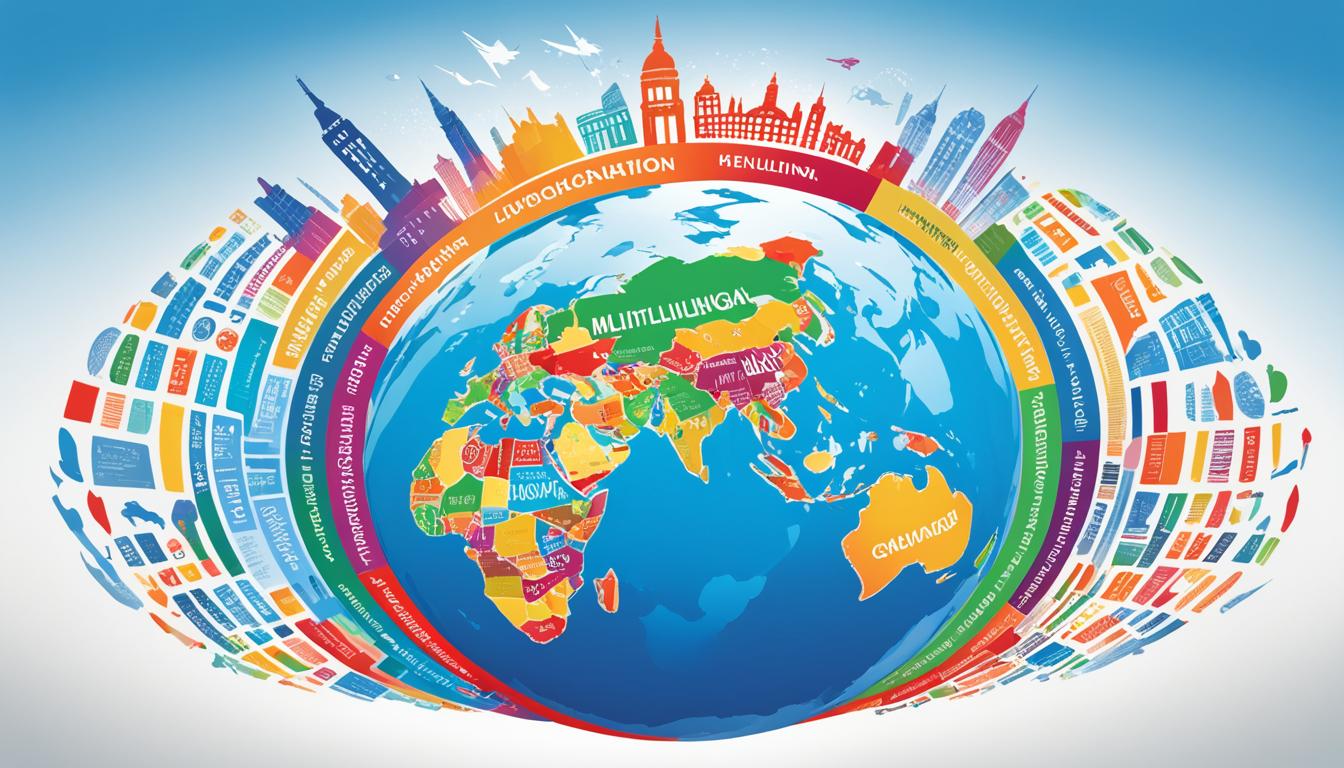In today’s world, global brands face big challenges in managing their reputation across different languages. This is key in digital marketing, where language and culture can greatly affect a company’s online image.
The global market offers many chances but also brings new challenges. As companies grow, they must handle their reputation in various languages and cultures. This has changed how we talk, making it more interactive, especially on social media1.
Now, people share their thoughts on review sites and social networks, affecting brands. Good reviews can spread fast, but bad ones can hurt a brand quickly1. This means companies need strong plans for managing their reputation in many languages.
When companies enter new markets, they often face problems with translation. A small mistake in a brand’s name or slogan can harm its image1. To avoid this, companies should invest in good language services. Working with experts in language is key to overcoming these challenges1.
Even though English is widely used online, it’s not enough for reaching all customers. People around the world want brands to speak their language. This shows the need for real, culturally aware communication1. It’s important for companies to adapt and understand the changing cultural trends, especially in places like Asia and Latin America1.
Key Takeaways
- Multilingual reputation management is crucial for global brands
- Social media has transformed brand-consumer interactions
- User-generated content significantly impacts brand reputation
- Translation errors can damage a brand’s image in new markets
- Quality language services are essential for effective communication
- Culturally sensitive communication is key to international success
The Importance of Language Diversity in Modern Reputation Management
Language diversity is key for global business success today. In our connected world, speaking many languages is vital for brand awareness and customer experience. Companies with teams that speak multiple languages can enter new markets, grow their reach, and increase profits2.
Using content in many languages helps businesses connect better with customers from different backgrounds. This leads to happier customers and stronger relationships3. Offering support in multiple languages shows a company cares about its customers and their culture, building trust and loyalty3.
Teams that speak many languages bring different viewpoints, leading to new solutions. These teams are more flexible and creative, making teamwork better even when everyone speaks the same language2. This diversity makes teams work better by removing language barriers3.
Social media is crucial for managing a company’s image across languages. Using these platforms with content in many languages helps companies reach more people and build a global presence. It’s important to know the cultural and legal rules of different markets to make smart choices2.
“Language diversity in the workplace has shifted from being a nice-to-have to a must-have attribute for any forward-thinking company in the global marketplace.”
Managing a team that speaks many languages has its challenges, like communication issues and cultural differences. But, with the right strategies, the benefits can be huge for companies in managing their reputation2.
Key Challenges in Multilingual Reputation Management
Managing a reputation in many languages is tough. Communication barriers can cause misunderstandings and delays. In fact, 29% of businesses lose customers because they don’t speak the customer’s language4.
Cultural differences can also clash with a company’s culture. This can hurt team unity and how feedback is given.
Legal and ethical issues get complicated when dealing with many languages. Companies must make sure everyone has the same chances, no matter their language skills. This is key, as 76% of consumers like products with info in their own language4.

Negative feelings can spread fast across language gaps. With over half of all Google searches worldwide in languages other than English, managing global perception is crucial4. Using professional language services is key to handling these issues5.
“Language in a professional context is the voice of a company and its brand in multilingual areas.”
To beat these challenges, businesses need to focus on real communication. They should use technology, keep data safe, manage quality, and work with trusted language service providers5. This way, they can get past language barriers and build a strong global reputation.
Best Practices for Effective Communication in Multilingual Environments
In today’s global workplace, talking to multilingual teams is key. Using A.I. for real-time language translation helps bridge language gaps in meetings or chats. It’s important to speak clearly, avoiding hard words to prevent confusion6.

Visual aids are crucial for helping with communication. Things like graphs, charts, and diagrams make complex ideas clear, even across language barriers. Adding these visuals helps during reviews and team talks6.
Listening well is also key. It means team members pay close attention and ask for clarification. This way, we catch any misunderstandings early. Feedback loops help us keep improving how we talk to each other.
An open-door policy builds trust. It lets team members share concerns or ask for help. This is really useful in multilingual teams, where different cultures can change how people talk6.
- Provide written feedback alongside verbal communication
- Use self-assessments and peer feedback to promote growth
- Offer cultural sensitivity training for managers
By following these tips, we can make our multilingual work environment more welcoming and effective. Remember, good communication is not just about speaking the same language. It’s also about understanding and valuing different views7.
Cultural Sensitivity and Inclusion in Multilingual Reputation Management
In our world where many languages are spoken, being sensitive to culture is key in managing reputations. We know how vital it is to grasp cultural subtleties beyond just language. This helps make a workplace that welcomes everyone. Managers who work across cultures face special hurdles in encouraging open talks and celebrating differences.
Training on cultural sensitivity is crucial for teaching employees. It helps build a welcoming space. Dr. Sayantani DasGupta, a doctor turned author and teacher at Columbia University, talks about the need for diverse stories in books for kids8. This idea also applies to work, where everyone’s voice should be heard and valued.

Teams made up of many cultures bring big benefits to companies, like deep market knowledge and customer service that understands people’s needs. But, these differences can cause problems if not handled right9. We need to work on four main areas: how people communicate, their language skills, views on hierarchy, and how they make decisions.
“Effective communication and critical listening are essential skills for healthcare providers and equally vital in managing multilingual teams.”
Unconscious bias is a big hurdle in working with many languages. We suggest acting early and setting clear rules to fix culture-related issues. Teams that succeed with cultural differences adapt, change their structure, get better management, or sometimes, they need to split up9.
| Challenge | Solution |
|---|---|
| Direct vs. Indirect Communication | Establish clear communication guidelines |
| Language Proficiency Issues | Provide language support resources |
| Differing Attitudes Toward Hierarchy | Create inclusive decision-making processes |
| Conflicting Decision-Making Norms | Develop consensus-building strategies |
By using these methods and valuing cultural awareness, we can make teams work better together. And we can handle our reputation well in a world where many languages are spoken. Remember, seeing issues as cultural, not personal, helps solve them better9.
Conclusion
We’ve looked into the complex world of managing reputations in our global business world. The challenges are tough, but there are also big chances to grow. We’ve seen how important it is to communicate well and understand different cultures.
In today’s digital world, one bad review can hurt a company’s image, even if it’s doing well10. This shows we need to manage our reputation well across languages and cultures. By using tools that analyze feelings and content that fits different cultures, companies can spot problems early and make their brand more visible10.
Good reputation management really matters. A huge 83% of customers stick with brands that listen to and fix their complaints11. This loyalty leads to real gains. Companies that used feedback in many languages saw a 20% jump in customer happiness and a 15% increase in yearly earnings12. These figures show the worth of having a team that speaks many languages and strong communication plans.
As we go forward, let’s keep in mind that managing a reputation in a world of many languages is more than just avoiding problems. It’s about taking chances to connect, grow, and succeed on a worldwide level. By valuing language diversity and being sensitive to cultures, we can create brands that stand strong and touch people all over the globe.
FAQ
What are the key challenges in managing a multilingual workforce for reputation management?
How can effective communication be achieved in multilingual teams?
Why is cultural sensitivity important in multilingual reputation management?
How can organizations support cross-cultural managers in multilingual teams?
What are the advantages of embracing language diversity in reputation management?
How can multilingual reputation management transform challenges into competitive advantages?
Source Links
- Linguistic Reputation Management for your business – https://swissglobal.ch/en/blog/why-language-is-crucial-to-your-reputation/
- Best Practices for Managing Multilngual Workforce | AllVoices – https://allvoices.co/blog/best-practices-for-multilingual-workforce
- Embracing Linguistic Diversity: The Importance of Multilingual Support in Today’s Day and Age – https://www.linkedin.com/pulse/embracing-linguistic-diversity-importance-multilingual-support-ykbfc
- Multilingual customer support: The key to global success – https://www.smartling.com/resources/101/multilingual-customer-support/
- Linguistic Reputation Management for your business | SwissGlobal – https://swissglobal.ch/en/blog/giving-companies-and-brands-a-language-of-their-own/
- Performance reviews for multilingual teams: A complete guide – https://eletive.com/blog/performance-reviews-for-multilingual-teams/
- Best Practices for Managing Multilingual Content and Translation Workflows – https://www.linkedin.com/pulse/best-practices-managing-multilingual-content
- Overcoming Language and Cultural Barriers: Promoting Inclusion in Multilingual and Multicultural Workplaces – https://www.nikawhite.com/overcoming-language-and-cultural-barriers-promoting-inclusion-in-multilingual-and-multicultural-workplaces
- Managing Multicultural Teams – https://hbr.org/2006/11/managing-multicultural-teams
- Multilingual Reputation Management – https://www.golden-way-media.com/multilingual-reputation-management/
- What Is Online Reputation Management (ORM)? – https://www.searchenginejournal.com/what-is-online-reputation-management-orm/473174/
- Multilingual Feedback Loops: Customer-Centric Iteration for Product Improvement – Customer Service Solutions – https://callnovo.com/multilingual-feedback-loops-customer-centric-iteration-for-product-improvement/

